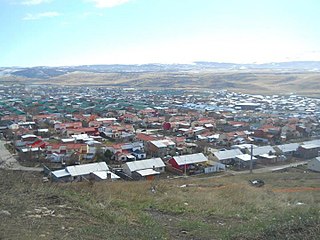
LADE - Líneas Aéreas del Estado is an airline based in Comodoro Rivadavia, Argentina. It is a state owned airline operated by the Argentine Air Force and provides domestic scheduled services mainly in Patagonia.

The Gallegos River is a river in the Argentine province of Santa Cruz, on whose estuary lies Río Gallegos city, capital of the province. Given that its basin reaches only the fringes of the Andes mountains it classifies as a sub-Andean river.

LRA Radio Nacional, also known as Radio Nacional Argentina, is the Argentine national radio station, and part of the national public media system. It started transmitting in 1937 as LRA Radio del Estado and changed its name to the current one in 1957. Since 1949, National Radio is also in charge of the Radiodifusión Argentina al Exterior, an international service that broadcasts in numerous languages.

28 de Noviembre, written out as Veintiocho de Noviembre, is a town in southwestern Santa Cruz Province, Argentina. It has roughly 5,300 inhabitants, most of whom are of Argentinian and Italian origin, and is located 270 km (168 mi) west of Río Gallegos and 13 km (8 mi) south of Río Turbio. The town is near the border with Chile, not far from Puerto Natales. Its main economic activity is coal mining.

The National University of Austral Patagonia is an Argentine national university in Santa Cruz Province. The university is divided into four campuses, located in the cities of Caleta Olivia (UACO), Río Gallegos (UARG), San Julián (UASJ) and Río Turbio (UART), and was founded in 1995, by national law 24.446.

The Turbio River rises in a mountainous region of the Argentine Andes and discharges to the Última Esperanza Sound in Chile. Río Turbio headwaters are in a part of the Andes where there is no central valley, or gap between the eastern and western ridges. Not far from its mouth to the northwest lies the Cueva del Milodón Natural Monument, where remains of the extinct giant sloth have been discovered, along with evidence of habitation by early man c. 10,000 BC.
The following radio stations broadcast on AM frequency 620 kHz: 620 AM is a Regional broadcast frequency.
The Jorquera River is a watercourse in the Atacama Region that originates in the foothills of the Andes give the confluence of the Turbio River, which comes from the east, and the Figueroa River, which comes from the north. and at its confluence with the Pulido River it forms the Copiapó River.

Güer Aike Department is a department in Santa Cruz Province, Argentina. It has a population of 113,267 and an area of 33,841 km². The seat of the department is in Río Gallegos which also has the majority of the population with 97,742. Veintiocho de Noviembre has the next largest population with 6,145 inhabitants. The name means 'large camp' in the aonikenk language of southern Patagonia.
Río Turbio is a town and municipality in the Güer Aike Department of the Santa Cruz Province in southern Argentina.
Alejandro Wehner was an Argentinian film director. His work included Diez segundos (1949), Rio turbio (1951) and Fierro a fondo (1952).
YCF, acronym for Yacimientos Carboníferos Fiscales, was an Argentine state-owned company dedicated to exploiting coal deposits in the Argentine mainland, mainly the field near to Rio Turbio.
Río Turbio Airport is an airport serving Río Turbio, a town in the Santa Cruz Province of Argentina. The airport is just south of 28 de Noviembre, a town 10 kilometres (6 mi) southeast of Rio Turbio.
Río Turbio is a town in Santa Cruz Province, Argentina.

Yacimientos Carboníferos Río Turbio is an Argentinian coal mining company created in 1994 to replace Yacimientos Carboníferos Fiscales, along with the privatization of many other state-owned enterprises, the trademark of the national administration of the time. It was created to extract, ship and sell the coal from Rio Turbio and its coal basin. It is the only coal mine in all of Argentina and a geopolitical key are, since it is located in the south west extreme of the country, one of the furthest south settlements of the country.

The Penitente River is a river located in southern Patagonia. The river originates in Chile in the south and flows north into Argentina. Somewhere in Argentina the river gives origin to Gallegos River, but sources disagree wehter this happens at confluence of it with Rubens River or with Turbio River.
This page is based on this
Wikipedia article Text is available under the
CC BY-SA 4.0 license; additional terms may apply.
Images, videos and audio are available under their respective licenses.








